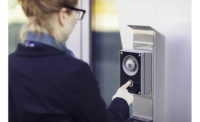LIKE THE ACCESS CONTROL MARKET as a whole, intercoms and entry control products are facing many changes due to the coronavirus pandemic. Controlling who enters your building is more important than ever, and the proper entry control system is what keeps employees, visitors and tenants safe, secure and healthy.
Not only have the events of the past year made entry control and intercoms more important, but they also altered the way in which the technology is used.
“As a result of the impacts of COVID-19, more people are working from home, and as residence committees become more connected, people will have a greater need for visitors of all types, as well as more flexible and secure entry control solutions in common areas for business meetings, package and food delivery and more,” says Tom Bowles, multi-housing national strategic partnership manager at dormakaba Americas, Indianapolis. “COVID-19 has also increased demand for touch-free entry into buildings through devices such as automatic door openers that secure entry and simplify access control.”
Bruce Czerwinski, vice president of sales and business development for safety and security at Zenitel Americas, Kansas City, Mo., says the pandemic has created a new security perimeter — one that demands contactless access with entry and exit, and that has also created a new duty of care for security professionals.
“There continues to be a need to interact and communicate with individuals moving in and out of doors and spaces without physical intervention,” he explains. “Intelligent communications, integrated with contactless access control, can help a business comply with pandemic safety guidelines.”
COVID-19 has also increased the need for quarantine spaces where the risk of infection is high and equipment must be regularly disinfected — particularly in the healthcare vertical. “Here, purpose-built clean room intercoms, providing clear, touchless communications, have emerged as critical tools for enabling patient care while reducing the need to enter the contaminated space,” Czerwinski says. “For example, voice communication can enable hospital staff to verify identity and to communicate with patients without entering the infectious environment, which can reduce the amount of exposure to the virus. In non-emergency healthcare facilities, such as medical centers, voice can effectively relay information to building occupants and visitors for screening. A patient who seeks access to a medical center for an appointment can hear important instructions from a nurse via the intercom solution.”
The pandemic has not only created new perimeters, but new walls as well, explains Adam Reed, director of sales for the Western U.S. at Aiphone Corp., Redmond, Wash. “Many customers are now installing plexiglass barriers in their environments, which is sometimes requiring the need to also add an intercom to improve communication.”
Shifting Preferences
Even before the pandemic, end users had started demanding entry control solutions they can manage from their mobile phone.
“More and more companies are offering mobile app solutions as key cards are easily lost and becoming more obsolete,” says Damon Chou, solutions product manager for Dahua Technology USA, Irvine, Calif. “We see contactless entry as something for the future.”
The market is rapidly moving to cloud programming and smartphone applications for entry control now, while video becomes a big trend, says Richard Sedivy, director of marketing and regulatory affairs at DoorKing, Inglewood, Calif.
“Video will become the standard communication means along with cloud-based databases for entry control,” Sedivy says. “DoorKing recently released its Cloud Programming product, which allows owners to take control of, and manage, their telephone entry, intercom and access control system from their laptop, tablet or smartphone, with no software or applications to download.”
Bruce Stewart, business development manager for Axis Door Solutions, Chelmsford, Mass., says that touch-free entry control is now seen as essential for many office spaces.
“COVID-19 has had a very measurable impact on entry control solutions,” Stewart says. “In just about every work environment, employees, customers and visitors are now reluctant or avoidant when it comes to physically touching PIN readers or door handles. Touch-free entry control is in high demand, so developing and implementing technologies such as Bluetooth, wave or motion triggers, mobile solutions and biometric recognition is essential to reducing contact and curbing the spread of viruses.”
Reed has also seen a rise in demand for touchless intercom solutions. “Touchless entry control solutions are a popular topic these days,” he says. “As people are much more concerned about cleanliness and better sanitation practices, being able to use an intercom without having to touch it is an attractive feature right now. Additionally, the ability to answer calls through mobile apps, or on personal devices, is also a popular conversation.”
Increased awareness around the benefits of touchless entry are causing the market to evolve, says Garrett Kaufman, president of Essex Electronics, Carpinteria, Calif.
“Initially, touchless control applications were most common in the healthcare setting, such as in hospitals and long-term facilities,” Kaufman says. “The recent pandemic has caused a surge in awareness surrounding these products, and now we are seeing them as a preferred option outside of healthcare and in more common settings, such as corporate and retail. Because our concerns and knowledge surrounding COVID-19 and other infectious diseases have increased, the market has truly evolved.”
Czerwinski believes audio controls will be the most popular form of touchless entry in the future.
“For intercom solutions, in the short term we see the addition of more touchless solutions, partly due to the COVID-19 pandemic,” he explains. “Long term, we will see audio become the new hub of the connected and intelligent school, facility, building, campus and more. Entry control and video will be controlled by audio, as audio provides interactivity in every situation. For example, through voice commands, security can tell entry control and video solutions what to do and when to do it. The result is a system that offers actionable insight into risks and potential physical breaches.”
As the technology used in entry control and intercom systems advances, it’s important to ensure everything is cyber-secure as well, Stewart warns.
“One evolving yet ever-present issue that dealers and integrators must pay attention to is cybersecurity,” he says. “Ensuring all vulnerable aspects of a system and its devices are as secure as possible throughout installation, integrations, upgrades, maintenance, etc. is crucial to providing a reliable solution and ultimately protecting people and property.”
What You Need to Know About Entry Control & Intercoms
Entry control and intercoms may not get as much attention as other types of security solutions, but they are an important part of any comprehensive system. Here, professionals in the space share what they think all integrators and dealers should know.
- “Prepare a demo kit to show the ease of use of each product. Know the scenario and application ahead of time so you can plan for the proper devices and components.” — Damon Chou, Dahua
- “Make sure that intercom solutions are a topic every salesperson addresses in their security consultations, and actively pursue the manufacturer’s product training to understand the full spectrum of where and how the product can be used.” — Adam Reed, Aiphone
- “First and foremost, I advise dealers and integrators to understand their customer’s needs. Having a clear understanding of what their customer’s goals are today, and in the future, will allow them to design a solution that can meet changing business needs. I’d also suggest that dealers and integrators seek devices built on open architecture in order to offer their customers a broader portfolio of solutions, greater functionality and easier integration and upgrades.” — Craig Szmania, business development manager, intercoms, Axis Communications
- “There is an opportunity for dealers and integrators to add audio to access control and video solutions that they sell, install and service to create a comprehensive and interactive security solution that reduces vulnerability to incidents, improves response time, provides a single point of control and provides a virtual presence to remote locations for situational awareness and management.” — Bruce Czerwinski, Zenitel
- “It’s important for dealers and integrators to be aware of changing end user needs in order to stock, sell and install product solutions that are fully capable of handling the functionality that property owners and end users want. And when dealers and integrators design products for a project, it’s a good idea to have a conversation with the property owner, architects and building contractors at the start of the process to decide whether to install an integrated intercom and reader or to install each separately on the wall.” — Tom Bowles, dormakaba
- “[Dealers and integrators] need to have options available as these systems are not one-size-fits-all. The application and specific owner requirements play a big part in how the controller is set up and programmed. What is the connection medium — cellular, internet, telephone, hard wired or wireless? Is software or cloud-based preferred?” — Richard Sedivy, DoorKing
What’s Next?
While many things may have changed in the past year, the market will continue to evolve rapidly in the near future, says Reed.
“I see that this is a need that is never going away,” Reed explains. “Some years ago, the industry recognized this as one of the primary areas with the most opportunity for growth. This has not changed. There are more requirements than ever before to have two-way communication in areas of refuge, in stairwells, on school campuses, between plexiglass barriers and more. I believe the future of intercoms will be a continued evolution into something far more comprehensive. In the beginning, intercoms were simply systems for communication. Then, they became entry control solutions with capabilities to release doors and capture video. Now, intercoms are needed to integrate with larger video management and access control systems, to be the primary paths of emergency communication with law enforcement and to be the alternative ways of communication with our mobile apps and other, more modern technological systems. Intercom and entry control solutions are needed now more than ever. They are here with us to stay.”
Like many areas in the security industry, integration is a large focus for those involved in the entry control market at the moment.
“In the future, we anticipate the current trend towards seamless integration of solutions will continue to evolve and grow,” Stewart says. “More and more, end users want a one system approach toward their facility’s needs. Dealers and integrators who offer solutions that build upon open architecture can more easily integrate new solutions and meet the growing demand for functionality and system scalability. On a similar note, there are still many outdated access control systems in service which will require migration to the network, which is where the future of intercoms and entry control lies.”
During these tumultuous times, all entry control and intercom solutions need to be reliable and dependable.
“We are living in unprecedented times due to the COVID-19 pandemic, as the disease places a significant risk to the health and safety of individuals who come in close contact with each other and those who enter a facility, whether to receive medical care, or to return to work,” Czerwinski says. “With that comes a higher duty of care that is placed upon security professionals, including dealers and integrators. That means that the security solutions they select and install must be more reliable than ever. It means not accepting poor audio or video quality with an intercom or entry control solution, but instead, seeking those solutions that provide powerful and proven audio technology and HD video, along with a touchless application, that work in every situation.”
And if you’re working with an end user who doesn’t have an intercom as a part of their system, Reed says it’s time to have a conversation.
“I am a firm believer that intercoms should play a significant role in every security access control conversation,” he says. “The fact that intercoms can provide communication, video identification, remote access capability, emergency notification and integrate into larger security networks makes them indispensable and necessary to any serious access control conversation.”











